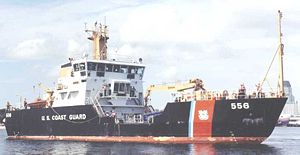Keeper-class cutter
 USCG coastal buoy tender Joshua Appleby WLM-556
| |
| Class overview | |
|---|---|
| Operators | |
| Built | 1995–2000 |
| In commission | 1996–present |
| Completed | 14 |
| Active | 14 |
| General characteristics [1] | |
| Displacement | 840 long tons (850 t) |
| Length | 175 ft (53.3 m) |
| Beam | 36 ft (11.0 m) |
| Draft | 7.9 ft (2.4 m) |
| Propulsion |
|
| Speed | 12 kn (22 km/h; 14 mph) |
| Complement | 24 |
| Sensors and processing systems | Furuno SPS-50 navigation radar |


The United States Coast Guard commissioned a new Keeper class of coastal buoy tenders in the 1990s that are 175 feet (53 m) in length and named after lighthouse keepers.
Keeper-class cutters serve the Coast Guard in a variety of missions and are tasked with maintaining aids to navigation (ATON), search and rescue (SAR), law enforcement (LE), migrant interdiction, marine safety inspections, environmental protection and natural resources management. Keeper-class cutters are also used for light ice breaking operations.
These vessels are 175' long and replaced the World War II era 180', 157' and 133' tenders. The new class of buoy tender cut crew size from 50, 35 and 26, respectively, to 25, saving the already cash-strapped Coast Guard financial and personnel resources.
Keeper-class cutters were built by Marinette Marine of Marinette, WI.
Keeper-class cutters are equipped with mechanical Z-drive azimuth thruster propulsion units instead of the standard propeller and rudder configuration. These mechanical drives are designed to independently rotate 360 degrees. Combined with a thruster in the bow, they enable Keeper-class tenders to dynamically maneuver in a variety of sea states. This creates an extremely maneuverable platform which, when combined with modern navigation aids such as GPS, DPS, and ECDIS to allow the Cutter to maintain static positions. This allows the cutter to precisely place an aid to navigation (ATON).
Keeper-class boarding teams are armed with modern small arms.
List[]
The following 175-foot WLMs in service (as of 2006):
| Cutter | Homeport | Namesake | Laid down | Launched[1] | Completed[1] |
|---|---|---|---|---|---|
| USCGC Ida Lewis (WLM-551) | Newport, Rhode Island | Ida Lewis | 23 January 1995[2] | 14 October 1995 | 1 November 1996 |
| USCGC Katherine Walker (WLM-552) | Bayonne, New Jersey | Katherine Walker | 8 April 1996[2] | 14 September 1996 | 27 June 1997 |
| Rockland, Maine | Abbie Burgess | 26 September 1996[2] | 5 April 1997 | 19 September 1997 | |
| South Portland, Maine | Marcus Hanna | 22 August 1996[2] | 23 August 1997 | 26 November 1997 | |
| Baltimore, Maryland | James Rankin | 21 April 1997[2] | 25 April 1998 | 26 August 1998 | |
| USCGC Joshua Appleby (WLM-556) | St. Petersburg, Florida | Joshua Appleby | 8 August 1998 | 20 November 1998 | |
| Portsmouth, Virginia | Frank Drew | 5 December 1998 | 17 June 1999 | ||
| USCGC Anthony Petit (WLM-558) | Ketchikan, Alaska | Anthony Petit | 30 January 1999 | 1 July 1999 | |
| Mobile, Alabama | Barbara Mabrity | 27 March 1999 | 29 July 1999 | ||
| Philadelphia, Pennsylvania | William Tate | 8 May 1999 | 16 September 1999 | ||
| Galveston, Texas | Harry Claiborne | 26 June 1999 | 28 October 1999 | ||
| Atlantic Beach, Florida | Maria Bray | 28 August 1999 | 6 April 2000 | ||
| USCGC Henry Blake (WLM-563) | Everett, Washington | Henry Blake | 20 November 1999 | 18 May 2000 | |
| San Pedro, California | George Cobb | 18 December 1999 | 22 June 2000 |
See also[]
Notes[]
- Citations
- References cited
- Baker, A. D. The Naval Institute Guide to Combat Fleets of the World 1998–1999. Annapolis, Maryland, USA: Naval Institute Press, 1998. ISBN 1-55750-111-4.
- Saunders, Stephen. Jane's Fighting Ships 2002–2003. Coulsdon, UK: Jane's Information Group, 2002. ISBN 0710624328.
Further reading[]
- Putnam, George R., Lighthouses and Lightships of the United States (Boston: Houghton Mifflin Co., 1933).
- United States Coast Guard, Aids to Navigation (Washington, D.C.: U. S. Government Printing Office, 1945).
- Price, Scott T. "U. S. Coast Guard Aids to Navigation: A Historical Bibliography". United States Coast Guard Historian's Office.
External links[]
- Current boats in service at the Library of Congress Web Archives (archived 2001-11-23)
- Keeper class characteristics
- Keeper-class cutters
- Lighthouse keepers
- 1990s ships
- Auxiliary tender classes
- United States Coast Guard stubs
- United States naval ship stubs